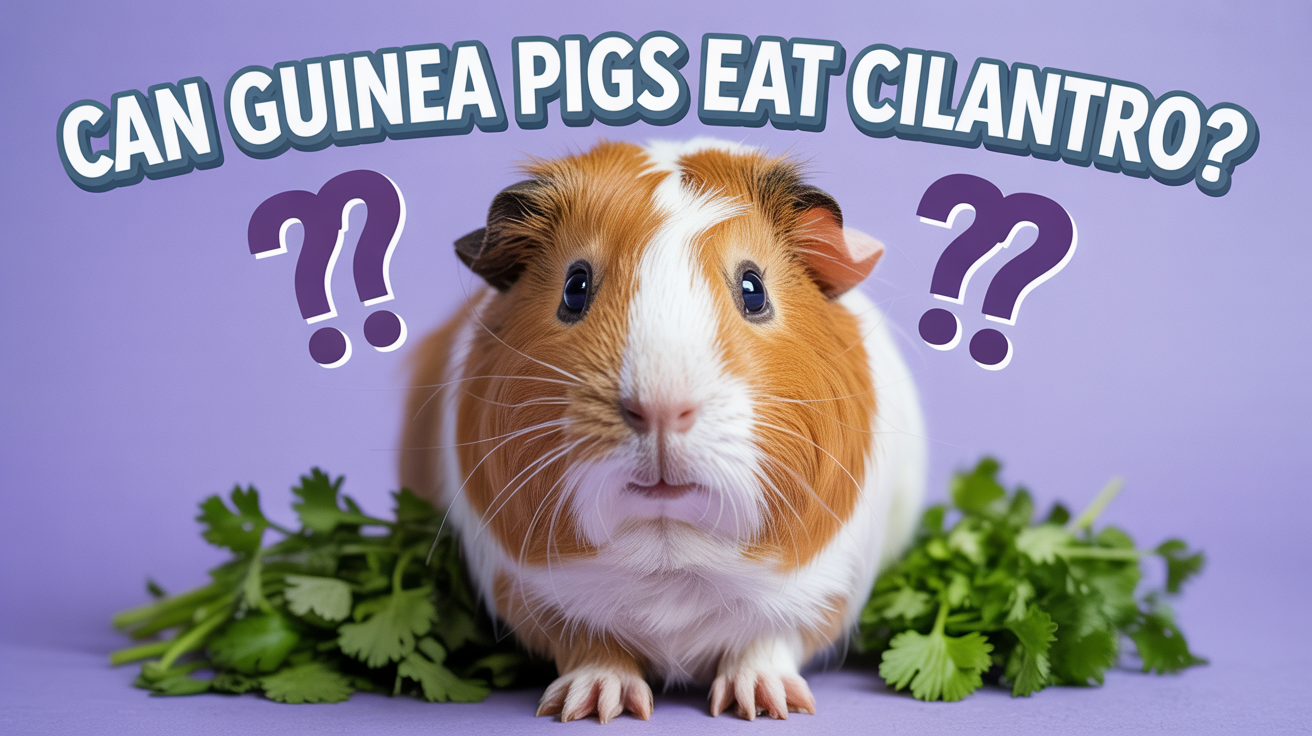
Can Guinea Pigs Eat Cilantro? Your Cavy Will Love This Herb
After caring for over thirty guinea pigs at my rescue and dealing with countless dietary questions from new owners, I can confidently say that yes, guinea pigs can absolutely have cilantro—and most of them love it! In fact, cilantro ranks among the safest and most beneficial herbs you can offer your cavy, providing essential vitamin C while being gentle on their sensitive digestive systems.
My guinea pigs go absolutely wild for cilantro, popcorning and wheeking the moment they smell it. Unlike some vegetables that require careful portion control, cilantro can be fed daily in reasonable amounts. Through years of experience and consulting with exotic veterinarians, I’ve found cilantro to be one of the most versatile and well-tolerated additions to a guinea pig’s diet.
Nutritional Benefits of Cilantro
Vitamin C Content
Guinea pigs, like humans, cannot produce their own vitamin C and require daily dietary intake to prevent scurvy. Cilantro provides approximately 27mg of vitamin C per 100 grams, making it an excellent supplementary source. While not as high as bell peppers or kale, cilantro’s vitamin C content combined with its high palatability makes it valuable for ensuring consistent intake.
I’ve successfully used cilantro to help recuperating guinea pigs who refuse other vegetables. My rescue pig Patches, recovering from dental surgery, would only eat cilantro for three days. The vitamin C helped his healing while maintaining his appetite. Fresh cilantro retains more vitamin C than wilted, so I always check for crisp, green leaves when shopping.
Other Essential Nutrients
Beyond vitamin C, cilantro offers valuable nutrients without problematic excesses. It contains moderate calcium levels (67mg per 100g), lower than parsley or dandelion greens which can contribute to bladder stones. The calcium-to-phosphorus ratio of 1.4:1 falls within the safe range for guinea pigs.
Cilantro provides vitamin A for eye health, vitamin K for blood clotting, and folate for cell function. The herb contains antioxidants that support immune function—particularly beneficial for senior pigs or those recovering from illness. Its high water content (92%) helps with hydration, especially important for guinea pigs who don’t drink enough water.
Safe Serving Sizes and Frequency
Daily Portion Guidelines
Through trial and error with numerous guinea pigs, I’ve found the ideal serving is 10-15 sprigs (about 1/4 cup chopped) per pig daily. This amount provides nutritional benefits without overwhelming their digestive system or unbalancing their diet. Younger guinea pigs under six months can have slightly less, while pregnant or nursing sows benefit from slightly more.
I distribute cilantro throughout the day rather than giving it all at once. Morning feeding might include 5-7 sprigs mixed with other vegetables, while evening vegetables include another 5-7 sprigs. This approach prevents selective eating where guinea pigs fill up on cilantro alone and ignore other important foods.
Introduction Methods
When introducing cilantro to guinea pigs who’ve never had it, start with 2-3 sprigs daily for three days, monitoring for any digestive upset. While rare, some guinea pigs have sensitive stomachs that need gradual introduction to new foods. Watch for soft stools or decreased appetite—signs to reduce quantity temporarily.
Most guinea pigs accept cilantro immediately, but I’ve encountered picky eaters who needed encouragement. Mixing small amounts of chopped cilantro with favorite vegetables helps create positive associations. One particularly stubborn pig only started eating cilantro after watching his cage mate enjoy it enthusiastically for a week.
Potential Concerns and Precautions
Calcium Considerations
While cilantro’s calcium content is moderate, guinea pigs prone to bladder stones need monitored intake. I’ve managed several pigs with bladder sludge who still enjoyed cilantro 3-4 times weekly rather than daily. The key involves balancing with low-calcium vegetables like bell peppers, cucumber, and lettuce.
Signs of excess calcium include white, gritty urine deposits and straining while urinating. If you notice these symptoms, reduce cilantro and other calcium-containing vegetables while consulting your veterinarian. However, don’t eliminate calcium entirely—guinea pigs need it for healthy bones and teeth.
Pesticide Risks
Conventionally grown cilantro often contains pesticide residues that can harm guinea pigs’ sensitive systems. I always wash cilantro thoroughly under running water, even organic varieties, to remove potential contaminants. Some sources recommend soaking in diluted vinegar solution, though I find thorough rinsing sufficient.
When possible, I buy organic cilantro or grow my own. Home-grown cilantro ensures pesticide-free herbs and provides the freshest possible nutrition. Several guinea pig owners I know maintain small herb gardens specifically for their pets. Even apartment dwellers can grow cilantro in windowsill containers.
Individual Sensitivities
While uncommon, some guinea pigs develop gas or bloating from cilantro. My rescue pig Whiskers couldn’t tolerate cilantro despite multiple attempts—it always caused soft stools within hours. These sensitivities appear more frequently in guinea pigs with existing digestive issues or those on antibiotics.
Watch for signs of discomfort including hunched posture, reduced activity, or grinding teeth (indicating pain). If cilantro consistently causes problems, plenty of alternatives exist. Never force a food that makes your guinea pig uncomfortable, regardless of its nutritional benefits.
How to Prepare and Serve
Washing and Storage
Proper preparation ensures safe cilantro consumption. I rinse bunches under cool running water, gently rubbing leaves to remove dirt and potential contaminants. Pat dry with paper towels or use a salad spinner—excess moisture can cause faster spoilage and potentially contribute to mouth sores in sensitive pigs.
Store cleaned cilantro wrapped in slightly damp paper towels inside a plastic bag in the refrigerator’s crisper drawer. This method keeps cilantro fresh for 5-7 days. Alternatively, place stems in a water glass like flowers, covering leaves with a plastic bag. Change water daily to prevent bacterial growth.
Serving Suggestions
Fresh presentation increases guinea pig interest and consumption. I serve whole sprigs rather than chopping, allowing guinea pigs to enjoy the natural foraging experience. Watching them hold stems with their tiny paws while munching leaves provides endless entertainment.
Mix cilantro with other vegetables for balanced nutrition. My standard veggie mix includes cilantro, bell pepper strips, cucumber slices, and romaine lettuce. Occasionally I create “salads” with cilantro as the base, topped with smaller portions of other vegetables. This variety prevents boredom and ensures comprehensive nutrition.
For medication administration, cilantro’s strong flavor helps mask bitter medicines. I’ll wrap liquid medication-soaked cilantro leaves around favorite treats, or use cilantro to encourage eating during illness recovery.
Comparing Cilantro to Other Herbs
Parsley vs Cilantro
Many owners wonder whether parsley or cilantro is better. Parsley contains more vitamin C (133mg per 100g versus cilantro’s 27mg) but also significantly more calcium (138mg versus 67mg). For healthy guinea pigs, I alternate between both herbs. However, for pigs with calcium issues, cilantro is the safer daily choice.
Parsley’s stronger flavor means some guinea pigs prefer cilantro’s milder taste. In my experience, about 70% of guinea pigs prefer cilantro when offered both simultaneously. The remaining 30% either prefer parsley or show no preference, eating whatever’s offered first.
Other Safe Herbs
Beyond cilantro and parsley, guinea pigs can enjoy basil, dill, mint, and oregano in moderation. Each offers different nutritional profiles and flavors. Basil provides anti-inflammatory properties, dill aids digestion, and mint can help with respiratory issues—though some pigs find mint too strong.
I rotate herbs throughout the week: cilantro Monday/Thursday, parsley Tuesday/Friday, basil Wednesday, and dill on weekends. This rotation provides variety while preventing nutrient imbalances. Most guinea pigs develop preferences, and I adjust accordingly while maintaining nutritional balance.
Growing Cilantro for Guinea Pigs
Indoor Growing Tips
Growing cilantro indoors ensures year-round pesticide-free herbs for your guinea pigs. Use containers at least 8 inches deep with drainage holes—cilantro has long taproots. Place in south-facing windows or under grow lights for 12-14 hours daily. Plant seeds every 2-3 weeks for continuous harvest.
Water when soil feels dry about an inch down, avoiding overwatering which causes root rot. Cilantro prefers cooler temperatures (60-70°F), making it perfect for indoor growing. My windowsill garden produces enough cilantro for four guinea pigs with just three rotating pots.
Outdoor Garden Options
Outdoor cilantro grows easily in partial shade, preferring cooler weather. Plant in spring and fall—summer heat causes premature bolting (flowering). Once cilantro bolts, leaves become bitter and less palatable to guinea pigs, though flowers are still safe to feed.
Succession planting every two weeks ensures continuous supply. I maintain a small raised bed specifically for guinea pig herbs, avoiding any pesticides or fertilizers that could harm them. Companion planting with nasturtiums helps deter aphids naturally.
Common Feeding Mistakes
Overfeeding Issues
The most common mistake I see is treating cilantro as the primary vegetable rather than part of a varied diet. While cilantro is safe daily, it shouldn’t comprise more than 20% of total vegetable intake. Guinea pigs need variety for complete nutrition—no single food provides everything they need.
Some owners, excited by their pig’s enthusiasm for cilantro, offer unlimited amounts. This can lead to decreased pellet consumption and potential nutrient deficiencies. Maintain consistent portions regardless of begging—those wheeks are persuasive but don’t indicate nutritional need!
Quality Problems
Feeding wilted, yellowing, or slimy cilantro can cause digestive upset or introduce harmful bacteria. I’ve treated guinea pigs with diarrhea from spoiled herbs that owners didn’t recognize as problematic. When in doubt, throw it out—it’s not worth risking your pig’s health.
Avoid cilantro with black spots, yellowing leaves, or strong odors beyond the normal cilantro scent. Check stems for mushiness or discoloration. If cilantro doesn’t look fresh enough for human consumption, it’s not appropriate for guinea pigs either.
Frequently Asked Questions
Can baby guinea pigs eat cilantro? Yes, baby guinea pigs over three weeks old can eat cilantro. Start with tiny amounts—just 1-2 small sprigs daily—gradually increasing as they grow. Young guinea pigs have more sensitive digestive systems, so introduction should be slower than for adults. My foster babies typically reach adult serving sizes around 4-5 months old.
Is cilantro better than lettuce for guinea pigs? Cilantro provides more vitamin C and nutrients than iceberg lettuce but shouldn’t replace all lettuce varieties. Romaine and green leaf lettuce offer different nutrients and higher water content. I recommend including both cilantro and appropriate lettuces in rotation for optimal variety and hydration.
Can guinea pigs eat cilantro stems? Absolutely! Cilantro stems are safe and many guinea pigs enjoy the crunchier texture. Stems contain similar nutrients to leaves and provide good chewing exercise. My guinea pigs often eat stems first, saving tender leaves for last—though each pig has individual preferences.
What if my guinea pig doesn’t like cilantro? Not all guinea pigs enjoy cilantro, and that’s perfectly normal. Try offering it different ways—whole, chopped, mixed with favorites, or at different times of day. If they still refuse after multiple attempts, focus on other vitamin C-rich vegetables like bell peppers or small amounts of kale.
Can I give my guinea pig dried cilantro? While dried cilantro isn’t toxic, fresh is significantly better. Drying eliminates most vitamin C and concentrates calcium. If using dried herbs, offer tiny pinches occasionally as flavoring rather than nutritional supplementation. Fresh cilantro should always be the primary choice for guinea pig consumption.
Making Cilantro Part of a Balanced Diet
Cilantro serves as an excellent component of a well-rounded guinea pig diet when offered appropriately. Its combination of moderate vitamin C, acceptable calcium levels, and high palatability makes it one of my go-to vegetables for both healthy guinea pigs and those needing dietary encouragement.
Remember that variety is key to guinea pig nutrition. While cilantro can be offered daily, rotate it with other vegetables, provide quality pellets, and ensure unlimited hay access. Monitor your guinea pig’s response to cilantro and adjust portions based on their individual needs and preferences.
The joy of watching guinea pigs eagerly munch cilantro while making happy sounds makes this herb a wonderful addition to their diet. With proper selection, storage, and serving, cilantro can contribute to your guinea pig’s health and happiness for years to come.


